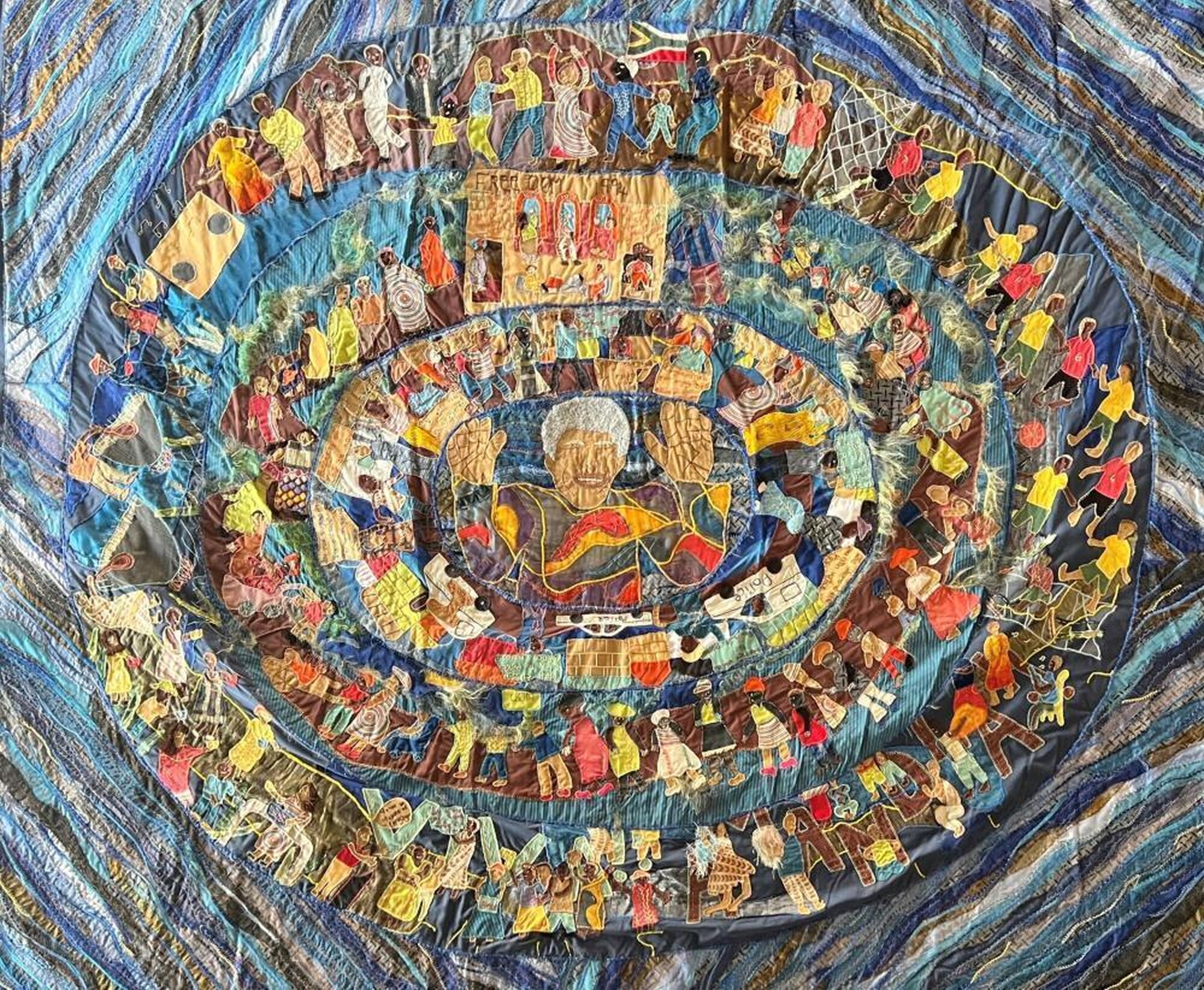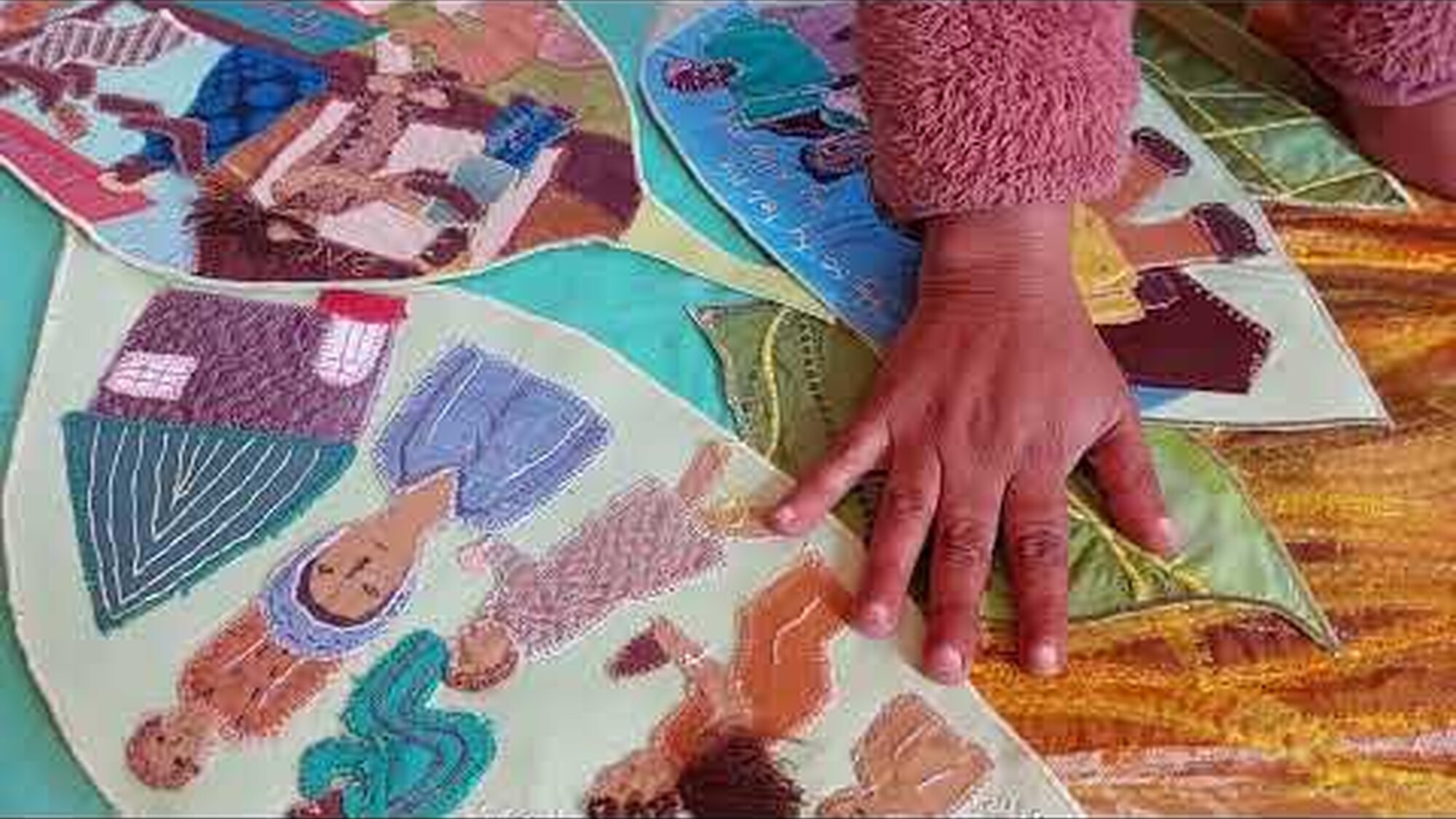Two iconic quilts of the Bethesda Arts Centre restored
Date posted: 27 October 2023 (Heritage Month)
We are grateful to the Bushman Heritage Museum (formerly Bethesda Arts Centre) who recently restored The Truth Tree, the iconic quilt they had made for the CCAC in 2006 and that is currently on display in our public gallery. Additionally, the restoration of another artwork that was made by this collective, The Freedom Quilt, is close to completion.
We are sharing a video and photographs of the restoration of The Truth Tree, along with a moving piece written by Jeni Couzyn, artistic director and founder of the Bethesda Arts Centre, about how the collective went about revisiting their work almost 18 years after it was made. She writes about how the collective felt is was necessary to adapt the works to some extent in order to reflect their artistic and personal growth over the years.
Photos and videos courtesy of the Bushman Heritage Museum.

The Truth Tree before and after restoration.
___
The Truth Tree and The Freedom Quilt
Written by: Jeni Couzyn, August 2023
These tapestries were made in 2006 by “coloured” women living in the township of Nieu-Bethesda, in the Eastern Cape. The women were working at the Bethesda Arts Centre (as it was known then), a project set up seven years earlier by myself, to help local people explore their identity through making art.
In 2006, when The Truth Tree was made, the suffering of the local people was an open secret that was never spoken about. Everyone knew what was happening behind closed doors. Often it happened in the street in front of everyone, but no one “saw” or admitted anything. If you had been beaten up, if you were hungry or heartbroken, you pretended you were fine. Abandonment, abuse, hunger, and alcoholism were the norm. Then the women at the Bethesda Arts Centre, (now the Bushman Heritage Museum) made The Truth Tree. Each woman told her story on a leaf with a picture of the injustice she was suffering, and with the telling of her story, she found words. A seismic shift in consciousness began to create the possibility for change.
At the same time, as a group we were studying the Constitution of 1996, and in particular the Bill of Rights, in a little book given to us as a gift by Albie Sachs. The law, enshrined in the Constitution, that stated that everyone has the right “To be free from all forms of violence, from either public or private sources” was a surprise to many of the women, as well as parents, teachers, and children. Speaking out opened the way for saying no to abuse, and exploring the theme in workshops (that sometimes included the police and head-teachers within the community). Overcoming addiction, and long-term self-exploration one-to-one, as well as within a group setting, followed. New skills were learned that enabled the women to earn an income. New self-respect resulted in the group by reclaiming their identity as Bushman artists. DNA tests confirmed their ethnicity. The Bushman Heritage Museum filled up with giant tapestries that have been exhibited all over the world.
The arrival of The Truth Tree for restoration almost twenty years later caused excitement and emotion for the group. For everyone it brought back intense memories. All the stories on the leaves were stories that the group identified as having been part of their own experience growing up, and all the women who had bravely told those stories were women they had known and loved. Many are still alive. The opportunity to make The Truth Tree beautiful and fresh again was seen as a great opportunity, and the artists wanted to honour the courage of the women who had broken the silence by retaining its authenticity.
For those who had been part of its original creation, when it arrived for restoration in 2023, it was a shock to see how much of the colour had been bleached out, how the fabric had frayed, and how the embroidery had deteriorated. The main damage had been caused by dust and direct sunlight. Sandra, the lead artist, knew at first glance exactly what she wanted to do. She began the process of restoration by taking the tapestry apart, piece by piece. All the Centre participants helped. Every stitch was carefully unpicked. The intention was to replace what had been damaged beyond repair with the same figures, forms and text, retaining the authenticity of the drawings each of the original artists had made to express her story in her leaf. Where necessary, faded fabric and thread were replaced, using the same colours. Each piece was given a backing of stiffening to prevent shrinkage and crumpling. The edges of synthetic pieces of fabric were sealed with heat, and the edges of cotton pieces sealed with machine overstitching to prevent fraying. Some of the hand embroidery was re-worked. When all the separate leaves had been refreshed, the tapestry was re-assembled by hand. The trunk of the tree had faded very badly, so more colour and detail were applied and some new insects created. The background was renewed and refreshed in the same way. All the leaves without figures and text were completely replaced.
At the centre the artists always work collectively. The group has changed over the years, and it now has four men, two of whom are artists, and two who work in supporting ways. During this restoration, Martin, who runs the Centre’s soup kitchen for the village children, made coffee and food to keep the group going during long days and late nights working. Jonathan, who grows the vegetables in the Centre garden, helped with fetching and carrying. Yvonne and Felicity, both very experienced and talented textile artists, performed miracles with tiny stitching. Gerald, who works with printmaking and textiles, cut and drew and stitched. Naasley, also a printmaker, unpicked and unpicked. Cherlyn, the new cleaner, stitched for the first time. Sandra guided everyone piece by piece. Jeni, the artistic director, kept a steadying eye.
Everyone agreed that restoring the piece had been an emotional experience, with sadness for the suffering, and joy at the beauty that was being created. The current restoration of TheFreedom Quilt is less poignant. Sandra commented that perhaps that is because in Nieu-Bethesda, people are still living “the Apartheid lives.” They all agree that for them their greatest freedom has been in recovering their identity as Bushmen through the work at the Bushman Heritage Museum. Their freedom is speaking out proudly as Bushmen. They have recovered their |Xam origins – a culture that had been completely lost to them. Now they are not “cultureless” as coloureds, which they were taught to believe. Their freedom is in sharing the rich mythology of their ancestors through their art and storytelling, and expressing themselves as Bushman artists.
However, the basic freedom of being recognised as a full human being, with the right to vote in a democratic election, is still understood and respected as a fundamental change that occurred in South Africa in 1994. On that freedom the freedom to rebuild an identity that was lost in the genocide of the Bushmen rests. For the privilege of being able to express that freedom at the Constitutional Court, the group is honoured. To restore The Freedom Quilt to its former power, the group decided to retain the central metaphor of the work. In the biblical story of the Pool of Jerusalem, there was a pool at the East gate of the city called the pool of Bethesda. In the story, when an angel stirred the water, anyone entering it was healed. The Freedom Quilt depicts such a pool in the village of Nieu-Bethesda. The energy stirring the water at the centre of the pool is represented by the figure of Nelson Mandela. The first outward ripple represents the coming of democracy and human rights to Bethesda in 1994, the second ripple represents the indigenous people of Bethesda learning about and reclaiming their Bushman origins and mythology, and the third ripple represents the artists of the Bushman Heritage Museum spreading this culture through exhibitions, books and storytelling throughout South Africa and abroad, while acknowledging the wider ongoing effects of constitutional democracy.
In order to restore The Freedom Quilt in its 2023 phase, the original structure has been kept. New figures, using the techniques we have developed over the years, have been made, first with individual artists making a number of drawings, and then collectively transforming those drawings into fabric. As in the original making of the piece, faces and people are based on real life people in the village. The second ripple introduces characters and events from the |Xam mythology as they are depicted in the tapestries and lino-pints and books in the Heritage museum. The third ripple depicts the current artists going into the wider world to make the |Xam mythology known.
At the museum, stories are told round fires to the local people and to tourists. The tapestries are exhibited in the museum galleries, and galleries around the world. The books are sold. The museum artists travel around schools in the Eastern, Western and Northern cape, telling the stories and giving out books to the teachers and children. Children are reminded that because of democracy, they like Mandela could perhaps one day be president.
The artists who made The Truth Tree and The Freedom Quilt in 2006
Artists: Sandra Sweers, Yvonne Jonkers, Millie Reed, Rose Jacobs, Maria Tamana, Margaret Swiers, Maggie Jacobs, Matilda Dikeni, Christelene Jacobs, Julia Malgas, Delia Swartz, Sophie Femela, Sophie Steenberg, Sanna Minnaar, and Shirlene Davids
Volunteers: Tarot Couzyn, Orla O’Flanagan
Artistic director, Jeni Couzyn
The artists who restored The Truth Tree and The Freedom Quilt in 2023
Sandra Sweers, lead artist
Yvonne (Jonkers) Merrington, senior textile artist
Felicity Tromp, senior textile artist
Gerald Mei, senior print maker
Naasley Swiers, senior print maker
Supporters: Martin Lackay, Cherlyn van Grense, and Jonathan Witbooi
Artistic director, Jeni Couzyn

The Freedom Quilt pre-restoration. The work will soon be returned to the Constitutional Court following the completion of the remedial work.






